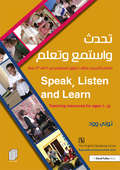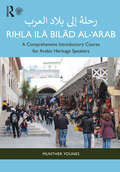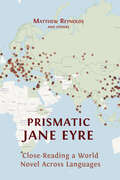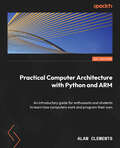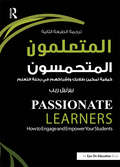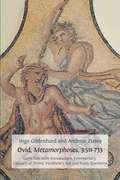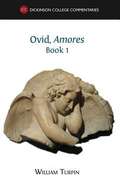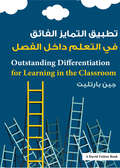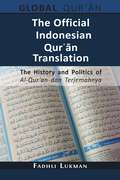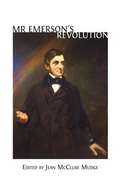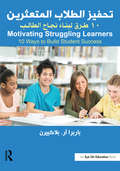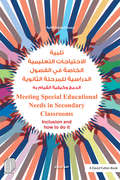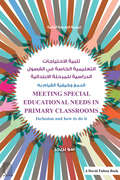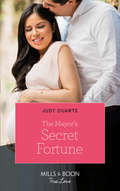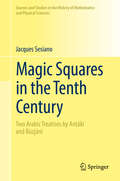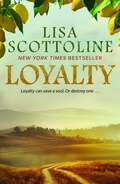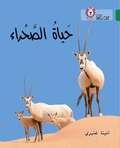- Table View
- List View
Speak, Listen and Learn: Teaching resources for ages 7-13, Arabic Edition
by Tony WoodThis indispensable resource, for teachers of pupils aged 7-13 years, consists of a series of graduated lesson plans aimed at improving children’s speaking and listening skills, their self-confidence and their motivation to learn, ultimately leading to better school performance. The scheme was developed and tested in schools during a four year period with over three thousand children and their teachers, and focuses on class and group activities that are enjoyable as well as instructive. All pupils are able to participate regardless of background, academic standing or facility in English, and the skills acquired are central to the National Curriculum for England and Wales Key Stages 2 and 3. Each lesson worksheet includes learning objectives, guidance on preparation and organisation, an activity guide, and follow-up suggestions, all presented in a clear and simple manner to lead the teacher step by step through the session. The materials are grouped into four levels of difficulty which combine to build a powerful range of abilities associated with persuasive and presentational speech, dialogue and debate, as well as developing the children’s command, use, and articulation of English. Each level consists of twelve starter lessons suitable for class-based group work, with sections preparing pupils for a variety of class competitions including public speaking, poetry reading and debating. The activities link naturally with other areas of the curriculum, and topics already being studied can easily be incorporated. In a parallel controlled research project highly significant gains in a nationally standardised test of non-verbal reasoning were made over a seven month period by children who followed the activities for one lesson a week compared to those who did not. These were well in excess of what would be expected for their increased age. Particularly high gains were made by children of lesser ability and those for whom English was an additional language. The improvements recorded were later confirmed by the schools’ own National Curriculum assessments of progress against targets, where on average the project children exceeded substantially the end of year forecasts made by their teachers.
Riḥla ilā Bilād al-‘Arab رحلة إلى بلاد العرب: A Comprehensive Introductory Course for Arabic Heritage Speakers
by Munther YounesRiḥla ilā Bilād al-‘Arab starts with the Arabic alphabet and gradually and systematically builds the reading and writing skills and mastery of Fuṣḥā grammar. As students develop their reading, writing, and grammar skills, they will be learning about Arab history, society, and culture. This book contextualizes Arabic grammar teaching with sufficient and relevant drills and exercises. Added personal and cultural interest is given by the diary of Amal, an American student of Arab descent, who travels to Jordan and Palestine. This textbook includes maps, illustrations, and photographs and is accompanied by audio on the companion website that can be viewed here: www.routledge.com/cw/younes . The book is designed for Arabic heritage students—students who can understand and speak an Arabic dialect (Egyptian, Iraqi, Moroccan, etc.) but are unfamiliar with Modern Standard Arabic, known as Fuṣḥā.
Riḥla ilā Bilād al-‘Arab رحلة إلى بلاد العرب: A Comprehensive Introductory Course for Arabic Heritage Speakers
by Munther YounesRiḥla ilā Bilād al-‘Arab starts with the Arabic alphabet and gradually and systematically builds the reading and writing skills and mastery of Fuṣḥā grammar. As students develop their reading, writing, and grammar skills, they will be learning about Arab history, society, and culture. This book contextualizes Arabic grammar teaching with sufficient and relevant drills and exercises. Added personal and cultural interest is given by the diary of Amal, an American student of Arab descent, who travels to Jordan and Palestine. This textbook includes maps, illustrations, and photographs and is accompanied by audio on the companion website that can be viewed here: www.routledge.com/cw/younes . The book is designed for Arabic heritage students—students who can understand and speak an Arabic dialect (Egyptian, Iraqi, Moroccan, etc.) but are unfamiliar with Modern Standard Arabic, known as Fuṣḥā.
A Relational Realist Vision for Education Policy and Practice
by Basem AdiThis volume argues that relational realism can help us to make better educational policy that is more effective in practice. Basem Adi draws on critical realism to thoroughly re-examine fundamental assumptions about how government policymaking works, developing an ontological basis from which to examine existing government approaches and imagine an alternative approach based on a relational realist-informed critical pedagogy.
A Relational Realist Vision for Education Policy and Practice
by Basem AdiThis volume argues that relational realism can help us to make better educational policy that is more effective in practice. Basem Adi draws on critical realism to thoroughly re-examine fundamental assumptions about how government policymaking works, developing an ontological basis from which to examine existing government approaches and imagine an alternative approach based on a relational realist-informed critical pedagogy.
Prismatic Jane Eyre: Close-Reading a World Novel Across Languages
by Matthew Reynolds OthersJane Eyre, written by Charlotte Brontë and first published in 1847, has been translated more than five hundred times into over sixty languages. Prismatic Jane Eyre argues that we should see these many re-writings, not as simple replications of the novel, but as a release of its multiple interpretative possibilities: in other words, as a prism. Prismatic Jane Eyre develops the theoretical ramifications of this idea, and reads Brontë’s novel in the light of them: together, the English text and the many translations form one vast entity, a multilingual world-work, spanning many times and places, from Cuba in 1850 to 21st-century China; from Calcutta to Bologna, Argentina to Iran. Co-written by many scholars, Prismatic Jane Eyre traces the receptions of the novel across cultures, showing why, when and where it has been translated (and no less significantly, not translated – as in Swahili), and exploring its global publishing history with digital maps and carousels of cover images. Above all, the co-authors read the translations and the English text closely, and together, showing in detail how the novel’s feminist power, its political complexities and its romantic appeal play out differently in different contexts and in the varied styles and idioms of individual translators. Tracking key words such as ‘passion’ and ‘plain’ across many languages via interactive visualisations and comparative analysis, Prismatic Jane Eyre opens a wholly new perspective on Brontë’s novel, and provides a model for the collaborative close-reading of world literature. Prismatic Jane Eyre is a major intervention in translation and reception studies and world and comparative literature. It will also interest scholars of English literature, and readers of the Brontës.
Prismatic Jane Eyre: Close-Reading a World Novel Across Languages
by Matthew Reynolds OthersJane Eyre, written by Charlotte Brontë and first published in 1847, has been translated more than five hundred times into over sixty languages. Prismatic Jane Eyre argues that we should see these many re-writings, not as simple replications of the novel, but as a release of its multiple interpretative possibilities: in other words, as a prism. Prismatic Jane Eyre develops the theoretical ramifications of this idea, and reads Brontë’s novel in the light of them: together, the English text and the many translations form one vast entity, a multilingual world-work, spanning many times and places, from Cuba in 1850 to 21st-century China; from Calcutta to Bologna, Argentina to Iran. Co-written by many scholars, Prismatic Jane Eyre traces the receptions of the novel across cultures, showing why, when and where it has been translated (and no less significantly, not translated – as in Swahili), and exploring its global publishing history with digital maps and carousels of cover images. Above all, the co-authors read the translations and the English text closely, and together, showing in detail how the novel’s feminist power, its political complexities and its romantic appeal play out differently in different contexts and in the varied styles and idioms of individual translators. Tracking key words such as ‘passion’ and ‘plain’ across many languages via interactive visualisations and comparative analysis, Prismatic Jane Eyre opens a wholly new perspective on Brontë’s novel, and provides a model for the collaborative close-reading of world literature. Prismatic Jane Eyre is a major intervention in translation and reception studies and world and comparative literature. It will also interest scholars of English literature, and readers of the Brontës.
Pre-Raphaelites: Beauty and Rebellion
by Christopher NewallFascinating new research into Pre-Raphaelite painters and collectors in Northern England positions Liverpool as the Victorian art capital of the north in Pre-Raphaelites: Beauty and Rebellion.This catalogue accompanies the first exhibition to examine Liverpool’s role in the history of the Pre-Raphaelite movement.The exhibition will be held at the Walker Art Gallery, Liverpool, from 12 February to 5 June 2016, and is being produced by National Museums Liverpool, working with the specialist art historian Christopher Newall, whose insightful essays will feature in the book.Containing new research on Pre-Raphaelite patrons and painters in Liverpool, including the collector John Miller and the artist John Ingle Lee, the book examines the relationship between artists like Ford Madox Brown and Rossetti with their Liverpool contemporaries, collectors, and the institutions that welcomed them, notably the forward-thinking Liverpool Academy. It will serve as an account of an important aspect of British artistic culture in the 19th century - and yet one for which there is no previous source of information.It will also feature approximately 100 works from the exhibition.
Practical Computer Architecture with Python and ARM: An Introductory Guide For Enthusiasts And Students To Learn How Computers Work And Program Their Own
by Alan ClementsAn introductory guide for enthusiasts and students to learn how computers work and program their own
Passionate Learners: How to Engage and Empower Your Students, Arabic Edition
by Pernille RippWould you want to be a student in your own classroom? In Passionate Learners: How to Engage and Empower Your Students, author Pernille Ripp challenges both novice and seasoned teachers to create a positive, interactive learning environment where students drive their own academic achievement. You’ll discover how to make fundamental changes to your classroom so learning becomes an exciting challenge rather than a frustrating ordeal. Based on the author’s personal experience of transforming her approach to teaching, this book outlines how to: • Build a working relationship with your students based on mutual trust, respect, and appreciation. • Be attentive to your students’ needs and share ownership of the classroom with them. • Break out of the vicious cycle of punishment and reward to control student behaviour. • Use innovative and creative lesson plans to get your students to become more engaged and intellectually-invested learners, while still meeting your state standards. • Limit homework and abandon traditional grading so that your students can make the most of their learning experiences without unnecessary stress. • And much more! New to the second edition, you’ll find practical tools, such as teacher and student reflection sheets, parent questionnaires, and parent conference tools--available in the book and as eResources on our website (http://www.routledge.com/9781138916920)—to help you build your own classroom of passionate learners.
Ovid, Metamorphoses, 3.511-73
by Ingo Gildenhard Andrew ZissosThis extract from Ovid's 'Theban History' recounts the confrontation of Pentheus, king of Thebes, with his divine cousin, Bacchus, the god of wine. Notwithstanding the warnings of the seer Tiresias and the cautionary tale of a character Acoetes (perhaps Bacchus in disguise), who tells of how the god once transformed a group of blasphemous sailors into dolphins, Pentheus refuses to acknowledge the divinity of Bacchus or allow his worship at Thebes. Enraged, yet curious to witness the orgiastic rites of the nascent cult, Pentheus conceals himself in a grove on Mt. Cithaeron near the locus of the ceremonies. But in the course of the rites he is spotted by the female participants who rush upon him in a delusional frenzy, his mother and sisters in the vanguard, and tear him limb from limb. The episode abounds in themes of abiding interest, not least the clash between the authoritarian personality of Pentheus, who embodies 'law and order', masculine prowess, and the martial ethos of his city, and Bacchus, a somewhat effeminate god of orgiastic excess, who revels in the delusional and the deceptive, the transgression of boundaries, and the blurring of gender distinctions. This course book offers a wide-ranging introduction, the original Latin text, study aids with vocabulary, and an extensive commentary. Designed to stretch and stimulate readers, Gildenhard and Zissos's incisive commentary will be of particular interest to students of Latin at AS and undergraduate level. It extends beyond detailed linguistic analysis to encourage critical engagement with Ovid's poetry and discussion of the most recent scholarly thought.
Ovid, Amores (Book 1)
by William TurpinFrom Catullus to Horace, the tradition of Latin erotic poetry produced works of literature which are still read throughout the world. Ovid’s Amores, written in the first century BC, is arguably the best-known and most popular collection in this tradition. Born in 43 BC, Ovid was educated in Rome in preparation for a career in public services before finding his calling as a poet. He may have begun writing his Amores as early as 25 BC. Although influenced by poets such as Catullus, Ovid demonstrates a much greater awareness of the funny side of love than any of his predecessors. The Amores is a collection of romantic poems centered on the poet’s own complicated love life: he is involved with a woman, Corinna, who is sometimes unobtainable, sometimes compliant, and often difficult and domineering. Whether as a literary trope, or perhaps merely as a human response to the problems of love in the real world, the principal focus of these poems is the poet himself, and his failures, foolishness, and delusions. By the time he was in his forties, Ovid was Rome’s most important living poet; his Metamorphoses, a kaleidoscopic epic poem about love and hatred among the gods and mortals, is one of the most admired and influential books of all time. In AD 8, Ovid was exiled by Augustus to Romania, for reasons that remain obscure. He died there in AD 17. The Amores were originally published in five books, but reissued around 1 AD in their current three-book form. This edition of the first book of the collection contains the complete Latin text of Book 1, along with commentary, notes and full vocabulary. Both entertaining and thought-provoking, this book will provide an invaluable aid to students of Latin and general readers alike. This book contain embedded audio files of the original text read aloud by Aleksandra Szypowska.
Outstanding Differentiation for Learning in the Classroom: Arabic Edition
by Jayne BartlettOne of the key features of an outstanding lesson is that all learners make progress. All learners are different and teachers must differentiate according to the individual pupil and their individual learning needs to achieve outstanding progress. Outstanding Differentiation for Learning in the Classroom is written with the class teacher in mind and demonstrates how differentiation can be used to enhance and support all aspects of the learning process. Including chapters on embedding differentiation during each phase of the lesson, assessment and questioning techniques, this book will help you to use differentiation effectively to produce outstanding results. With a strong focus on practical strategies to help you meaningfully apply differentiation in the classroom, this book covers: what differentiation actually means and why it should be applied in the classroom; sequencing and planning for learning with an overview of the learning cycle; practical teaching strategies and effective techniques to use in the classroom; how to structure and apply differentiation practices in your classroom, department and school. A vital starting point and effective guide for outstanding differentiation, this timely new book is packed full of practical exercises that are easy to implement in the classroom and it is essential reading for newly qualified and experienced teachers alike.
The Official Indonesian Qur'ān Translation: The History and Politics of Al-Qur’an dan Terjemahnya
by Fadhli LukmanThis book studies the political and institutional project of Al-Qur’an dan Terjemahnya, the official translation of the Qurʾān into Indonesian by the Indonesian government. It investigates how the translation was produced and presented, and how it is read, as well as considering the implications of the state’s involvement in such a work.
A Musicology of Performance: Theory And Method Based On Bach's Solos For Violin
by Dorottya FabianThis book examines the nature of musical performance. In it, Dorottya Fabian explores the contributions and limitations of some of these approaches to performance, be they theoretical, cultural, historical, perceptual, or analytical. Through a detailed investigation of recent recordings of J. S. Bach’s Six Sonatas and Partitas for Solo Violin, she demonstrates that music performance functions as a complex dynamical system. Only by crossing disciplinary boundaries, therefore, can we put the aural experience into words. A Musicology of Performance provides a model for such a method by adopting Deleuzian concepts and various empirical and interdisciplinary procedures. Fabian provides a case study in the repertoire, while presenting new insights into the state of baroque performance practice at the turn of the twenty-first century. Through its wealth of audio examples, tables, and graphs, the book offers both a sensory and a scholarly account of musical performance. These interactive elements map the connections between historically informed and mainstream performance styles, considering them in relation to broader cultural trends, violin schools, and individual artistic trajectories. A Musicology of Performance is a must read for academics and post-graduate students and an essential reference point for the study of music performance, the early music movement, and Bach’s opus.
Mr. Emerson's Revolution
by Jean McClure MudgeThis volume traces the life, thought and work of Ralph Waldo Emerson, a giant of American intellectual history, whose transforming ideas greatly strengthened the two leading reform issues of his day: abolition and women’s rights. A broad and deep, yet cautious revolutionary, he spoke about a spectrum of inner and outer realities—personal, philosophical, theological and cultural—all of which gave his mid-career turn to political and social issues their immediate and lasting power. This multi-authored study frankly explores Emerson's private prejudices against blacks and women while he also publicly championed their causes. Such a juxtaposition freshly charts the evolution of Emerson's slow but steady application of his early neo-idealism to emancipating blacks and freeing women from social bondage. His shift from philosopher to active reformer had lasting effects not only in America but also abroad. In the U.S. Emerson influenced such diverse figures as Thoreau, Whitman, Dickinson and William James and in Europe Mickiewicz, Wilde, Kipling, Nietzsche, and Camus in Europe as well as many leading followers in India and Japan. The book includes over 170 illustrations, among them eight custom-made maps of Emerson's haunts and wide-ranging lecture itineraries as well as a new four-part chronology of his life placed alongside both national and international events as well as major inventions. Mr. Emerson's Revolution provides essential reading for students and teachers of American intellectual history, the abolitionist and women’s rights movement―and for anyone interested in the nineteenth-century roots of these seismic social changes.
Motivating Struggling Learners: 10 Ways to Build Student Success, Arabic Edition
by Barbara R. BlackburnEvery day, teachers face the challenge of motivating struggling learners. In this must-have book, Barbara R. Blackburn, author of the bestseller Rigor Is Not a Four-Letter Word, shares how you can finally solve this problem and make your classroom a rigorous place where all students want to succeed. You’ll learn practical strategies for... understanding extrinsic and intrinsic motivation; building a trusting relationship with students; using praise and positive feedback effectively; empowering students and helping them own their learning; moving students toward a growth mindset; communicating high expectations for students; engaging all students in your lessons; scaffolding so all students will want to improve; helping students be resilient and not fear failure; and celebrating diverse groups of students. Each chapter is filled with a variety of examples and tools that you can use immediately. Bonus: Many of the tools are also available as free eResources on our website, www.routledge.com/9781138792432, so you can easily download and print them for classroom use.
Meeting Special Educational Needs in Secondary Classrooms: Inclusion and how to do it, Arabic Edition
by Sue BriggsThere are greater numbers of children with Special Educational Needs and Disabilities (SEND) now attending mainstream schools. This fully updated and revised edition of Meeting Special Educational Needs in Secondary Classrooms is written by an experienced teacher, adviser and SEN consultant and explains the challenges that these children face. This is a practical book full of guidance for teachers and teaching assistants who support children with SEND in mainstream secondary classrooms. Now fully updated to include the requirements of the 2014 Children and Families Act and SEND Code of Practice, this book: covers all aspects of teaching children with SEND, including planning, teaching and learning promotes successful communication between teachers, parents and students contains photocopiable resources and templates. With practical guidance on how to make the curriculum more accessible for children with SEND, this book will help teachers and TAs work together to support pupils with Special Educational Needs and Disabilities more effectively.
Meeting Special Educational Needs in Primary Classrooms: Inclusion and how to do it, Arabic Edition
by Sue BriggsThere are greater numbers of children with Special Educational Needs and Disabilities (SEND) now attending mainstream schools. This fully updated and revised edition of Meeting Special Educational Needs in Primary Classrooms is written by an experienced teacher, adviser and SEN consultant and explains the challenges that these children face. This is a practical book full of guidance for teachers and teaching assistants who support children with SEND in mainstream primary classrooms. Now fully updated to include the requirements of the 2014 Children and Families Act and SEND Code of Practice, this book: contains photocopiable resources and templates promotes successful communication between teachers, parents and students covers all aspects of teaching children with SEND, including planning, teaching and learning. With practical guidance on how to make the curriculum more accessible for children with SEND, this book will help teachers and TAs work together to support pupils with Special Educational Needs and Disabilities more effectively.
The Mayor’s Secret Fortune: One Night To Remember / The Mayor's Secret Fortune (the Fortunes Of Texas: Rambling Rose) (Mills And Boon True Love Ser. #3)
by Judy DuarteIt’s too much, too soon. When wealthy contractor Steven Fortune proposes to Ellie Hernandez, the beautiful and principled mayor of Rambling Rose, Texas, no one is more surprised than Ellie herself. Until recently, Steven was practically her enemy! But his offer of a marriage of convenience arrives when the secretly pregnant mayor is at her weakest moment. They can pull off a united front for a short time, can’t they? Surely she won’t fall for another man who insists he isn’t interested in the long haul… USA TODAY Bestselling Author
Magic Squares in the Tenth Century: Two Arabic Treatises by Anṭākī and Būzjānī (Sources and Studies in the History of Mathematics and Physical Sciences)
by Jacques SesianoThis volume contains the texts and translations of two Arabic treatises on magic squares, which are undoubtedly the most important testimonies on the early history of that science. It is divided into the three parts: the first and most extensive is on tenth-century construction methods, the second is the translations of the texts, and the third contains the original Arabic texts, which date back to the tenth century.
The Life Of The Desert: Level 15 (Collins Big Cat Arabic Reading Programme Ser.)
by Anita Ganeri Collins Big CatLife Histories of Etnos Theory in Russia and Beyond
by David G. Anderson Dmitry V. Arzyutov Sergei S. AlymovThe idea of etnos came into being over a hundred years ago as a way of understanding the collective identities of people with a common language and shared traditions. In the twentieth century, the concept came to be associated with Soviet state-building, and it fell sharply out of favour. Yet outside the academy, etnos-style arguments not only persist, but are a vibrant part of regional anthropological traditions. Life Histories of Etnos Theory in Russia and Beyond makes a powerful argument for reconsidering the importance of etnos in our understanding of ethnicity and national identity across Eurasia. The collection brings to life a rich archive of previously unpublished letters, fieldnotes, and photographic collections of the theory’s early proponents. Using contemporary fieldwork and case studies, the volume shows how the ideas of these ethnographers continue to impact and shape identities in various regional theatres from Ukraine to the Russian North to the Manchurian steppes of what is now China. Through writing a life history of these collectivist concepts, the contributors to this volume unveil a world where the assumptions of liberal individualism do not hold. In doing so, they demonstrate how notions of belonging are not fleeting but persistent, multi-generational, and bio-social.
L’idée de l’Europe au Siècle des Lumières
by Rotraud Von Kulessa Et Catriona SethFace aux défis – entre autres politiques – auxquels sont confrontés différents pays européens, les chercheurs dix-huitiémistes ont souhaité revenir sur des expressions anciennes de valeurs partagées et les interrogations passées sur des questions qui restent souvent d’actualité. Au Siècle des Lumières, nombre d’hommes et de femmes de lettres ont envisagé l’avenir du continent en particulier pour entériner leur souhait de garantir la paix en Europe. Les textes, réunis dans cette anthologie, et signés des grands écrivains du temps (Rousseau, Montesquieu, Voltaire, Kant, Hume ou encore Staël), comme d’oubliés de l’histoire, présentent, avec quelques excursus chronologiques (de Sully à Hugo) les réflexions de penseurs d’un dix-huitième siècle aux bornes chronologiques étendues – l’émergence et la chute de l’Empire engendrent des bouleversements nombreux –, sur l’Europe, son histoire, sa diversité, mais aussi sur ce qu’ont en commun les nations qui composent, dans leur variété, un ensemble géographique. Ils mettent en évidence les origines historiques d’un projet d’union européenne, le souhait de consolider les liens du continent avec le Maghreb ou la Turquie, l’importance accordée au commerce et les inquiétudes suscitées par les sursauts de l’histoire, mais aussi l’espoir placé dans les générations futures. La Société française d’étude du XVIIIe siècle, l’Université d’Augsburg, l’Université d’Oxford ont généreusement contribué à la publication de ce volume. In view of the challenges—many of which are political—that different European countries are currently facing, scholars who work on the 18th century have compiled this anthology which includes earlier recognitions of common values and past considerations of questions which often remain pertinent nowadays. During the Enlightenment, many men and women of letters envisaged the continent’s future in particular when stressing their hope that peace could be secured in Europe. The texts gathered here, and signed by major thinkers of the time (Rousseau, Montesquieu, Voltaire, Kant, Hume or Staël for instance), as well as by writers history has forgotten, present the reflections, with a couple of chronological extensions (from Sully to Victor Hugo) of authors from the long eighteenth century—the French Empire and the fall of Napoleon generated numerous upheavals—on Europe, its history, its diversity, but also on what the nations, which, in all their diversity, make up a geographical unit, have in common. They show the historical origins of the project of a European union, the desire to consolidate the continent’s ties to the Maghreb or to Turkey, the importance granted to commerce and the worries engendered by history’s convulsions, but also the hope vested in future generations. The Société française d’étude du XVIIIe siècle, Augsburg University and the University of Oxford have generously contributed towards the publication of this volume.
